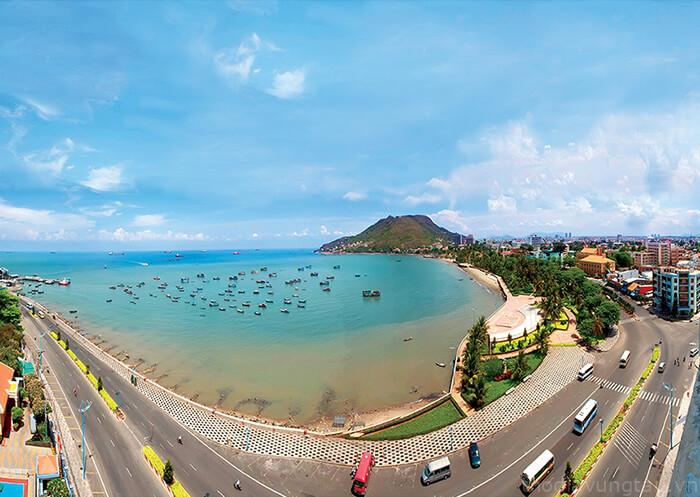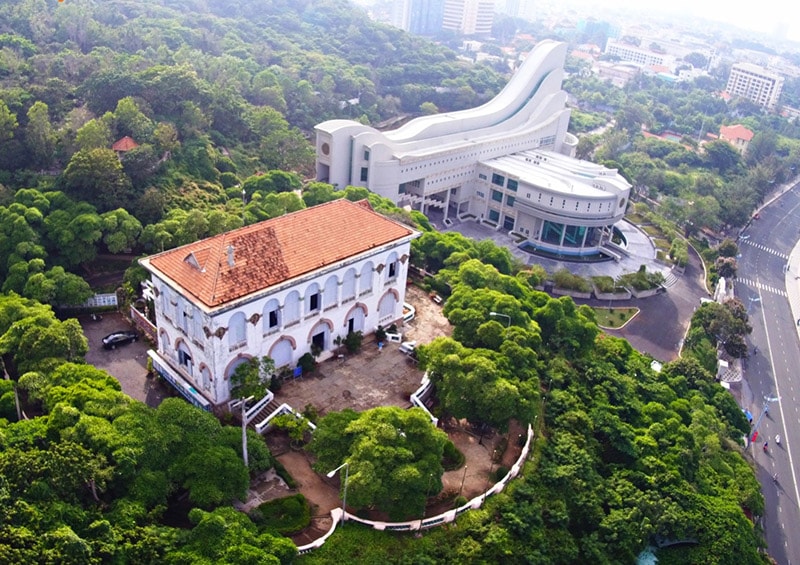What to visit in Vung Tau
Vung Tau, an enchanting coastal town, has much more to offer than just Bai Sau, Bai Truoc, Nui Lon, and Nui Nho. With its picturesque beaches and charming streets, there are numerous captivating places waiting for you to explore. Join us, along with the rivew of what to do in Vung Tau , as we delve into the wonders of Vung Tau!
Travel ExperienceWhat to visit in Vung Tau
- Bai Sau (Back Beach)
Bai Sau, a familiar beach for both locals and tourists alike, is nestled in the southeastern part of Vung Tau. Stretching from the foothills of Nui Nho to the Chí Linh area, Bai Sau stands as the primary beach destination in Vung Tau. Not only favored by tourists, but it’s also a beloved spot for local residents.
 Bai Sau boasts a gentle slope and calm waves, making it a perfect spot for swimming and enjoying the sea breeze. In addition to the beach, there’s Bai Sau Park and Bai Sau Square, providing a familiar recreational area for both fun and relaxation. Running alongside Bai Sau is Thuy Van Street, which has led to Bai Sau being alternatively known as Bai Thuy Van. This bustling street is Vung Tau’s main tourism route, lined with hotels, eateries, ensuring convenience for all visitors.
Bai Sau boasts a gentle slope and calm waves, making it a perfect spot for swimming and enjoying the sea breeze. In addition to the beach, there’s Bai Sau Park and Bai Sau Square, providing a familiar recreational area for both fun and relaxation. Running alongside Bai Sau is Thuy Van Street, which has led to Bai Sau being alternatively known as Bai Thuy Van. This bustling street is Vung Tau’s main tourism route, lined with hotels, eateries, ensuring convenience for all visitors.
For those looking to book Vung Tau hotels near Bai Sau, MoMo’s Travel & Transport feature offers great deals and easy reservation management.
Bai Truoc (Front Beach)
Although quieter, Bai Truoc is no less beautiful than its counterpart Bai Sau. Situated not far from Bai Sau, Bai Truoc is another popular destination in Vung Tau for its scenic views and tranquil atmosphere. Also referred to as Bai Tam Duong, Bai Truoc is a crescent-shaped bay nestled between Nui Lon and Nui Nho. It stretches from the beginning of Tran Phu Street to the end of Quang Trung Street and a section of Ha Long Street.

On both sides of Bai Truoc, you’ll find large and small stacked rocks forming a protective natural wall around the beach. Alongside Bai Truoc is Bai Truoc Park, adorned with beautiful coconut trees facing the sea.
- Nui Lon (Big Mountain)
Nui Lon, one of Vung Tau’s two beautiful mountains, spans approximately 400 hectares and hosts several renowned tourist sites such as Bach Dinh, the temple with the Thich Ca Phat Dai statue, and the Bai Dau Holy Mother Shrine.
At an elevation of 245 meters above sea level, the Vi Ba Men route offers breathtaking views of Vung Tau city from above. Around 5:00 PM, visitors can experience the exquisite Vung Tau sunset. Although the path is moderately steep, it is accessible to cars and is a popular choice for afternoon strolls and sightseeing.
- Bach Dinh (White Palace)
Located on the southern slope of Nui Lon, specifically at 4 Tran Phu Street, Ward 1, Vung Tau, Bach Dinh’s history dates back to Emperor Minh Mang, who initially constructed Phuoc Thang Fortress to control the Can Gio sea entrance.Later, during the French colonial period, the fortress was leveled, and a palace was built as a leisure retreat for the Indochina Governor-General. In 1907, this location became the imprisonment site of former Emperor Thanh Thai for a decade. Due to this history, locals also refer to it as Dinh Ong Thuong.
 Built in late 19th-century French architectural style, Bach Dinh overlooks Bai Truoc and is surrounded by lush greenery, especially porcelain trees. The palace features three levels: a basement, a ground floor, and a tall level painted white, from which it gets its name. The exterior boasts numerous arched windows and is adorned with eight half-body statues in Ancient Greek style. There are two entrances to the palace: a winding road suitable for cars beneath the shade of gia ty trees and a 146-step staircase flanked by porcelain trees, each providing a uniquely poetic atmosphere. what to visit in Vung Tau
Built in late 19th-century French architectural style, Bach Dinh overlooks Bai Truoc and is surrounded by lush greenery, especially porcelain trees. The palace features three levels: a basement, a ground floor, and a tall level painted white, from which it gets its name. The exterior boasts numerous arched windows and is adorned with eight half-body statues in Ancient Greek style. There are two entrances to the palace: a winding road suitable for cars beneath the shade of gia ty trees and a 146-step staircase flanked by porcelain trees, each providing a uniquely poetic atmosphere. what to visit in Vung Tau
- Thich Ca Phat Dai (Shakyamuni Buddha Tower)
Thich Ca Phat Dai is a complex of Buddhist architecture located on the northern slope of Nui Lon. Encompassing 28 hectares, this architectural masterpiece seamlessly blends natural landscapes with Buddhist structures. It includes various components: a cluster of temples including Ho Phap, Thien Lam, Di Lac, Vien Thong, a Xa Loi stupa, and a garden of statues depicting the life of Lord Buddha. Next what to visit in Vung Tau
 Among these, the Thich Ca Phat Dai statue stands out as a symbolic masterpiece. Depicting the seated Shakyamuni Buddha, the statue is backed by the Bodhi tree planted by Venerable Narada in 1960. The statue, with its pedestal standing 7 meters tall and the statue itself reaching 6 meters, features a body adorned with three sacred relics. In total, the complex houses 13 other relics within the Bao Thap stupa, contributing to the sanctity of the temple.
Among these, the Thich Ca Phat Dai statue stands out as a symbolic masterpiece. Depicting the seated Shakyamuni Buddha, the statue is backed by the Bodhi tree planted by Venerable Narada in 1960. The statue, with its pedestal standing 7 meters tall and the statue itself reaching 6 meters, features a body adorned with three sacred relics. In total, the complex houses 13 other relics within the Bao Thap stupa, contributing to the sanctity of the temple.
- Our Lady of Bai Dau Statue
Our Lady of Bai Dau is a renowned tourist spot in Vung Tau, not only for the faithful but also for visitors from around the world. Originally owned by Mr. and Mrs. Ve An, the land was later donated to the Paris Foreign Missions Society.
Subsequently, a shrine and a statue of the Holy Mother were erected, giving rise to the complex known as Our Lady of Bai Dau. The statue, constructed in 1992, stands 60 meters above sea level on the slope of Nui Lon. The white statue, standing at 15 meters tall and weighing nearly 500 tons, faces the sea and depicts the Holy Mother holding Jesus.

- Ho May (May Lake)
Ho May, a recreational and entertainment hub located at an altitude of 210 meters on Nui Lon, spans over 50 hectares. The expansive Ho May complex offers a variety of entertainment and sightseeing options suitable for all age groups, making it one of the most popular tourist destinations in Vung Tau.
For photography enthusiasts seeking Instagram-worthy shots, Ho May features areas that combine artificial structures with breathtaking natural scenery. Notable examples include the cherry blossom forest, the artificial lake, and the cascading waterfalls.Thrill-seekers can partake in exhilarating activities like skateboarding and ziplining, as well as other high-adrenaline experiences such as roller coasters and pirate ship rides.
Other attractions what to visit in Vung Tau
- Ba Mountain Ba Mountain
Ba Mountain is a small rocky island located near the sea, specifically at Bai Truoc Beach. The island has an area of about 5,000 square meters, located about 220 meters from the shore. The main attraction of this place is the Ba Mountain temple located right on the island, occupying almost the entire area of this rocky island. what to visit in Vung Tau next
In the 18th century, the people of Thang Tam village built a temple on the island to worship the Water Dragon goddess, praying for calm waves, gentle seas, and favorable winds for fishermen to go to sea. Therefore, the temple is also called “Mieu Ba,” and the rocky island is named Ba Mountain.
To reach Ba Mountain, visitors can take a boat. On the 14th and 15th lunar days, when the tide goes down, a stone path is exposed between Ba Mountain and the mainland, and visitors can choose this path to walk to the island, taking about 20-30 minutes.
- Christ the Redeemer Statue
When mentioning famous tourist destinations in Vung Tau, one cannot ignore the Christ the Redeemer statue on Little Mountain. When mentioning famous tourist destinations in Vung Tau, one cannot ignore the Christ the
The Christ the Redeemer statue in Vung Tau is known by various names such as Christ the Redeemer with outstretched arms, Christ the Redeemer on Little Mountain, and Christ the Redeemer King. This is a statue of Jesus Christ located on Little Mountain, a famous tourist spot and one of the symbols of the coastal city of Vung Tau.
The Christ the Redeemer statue on Little Mountain was constructed from 1974 to 1994. The statue is 32 meters tall, with arms spanning 18.4 meters. The statue is placed on a unique 10-meter high arch-shaped pedestal. In front of the statue is the bas-relief “The Last Supper,” and behind is “Jesus Giving the Keys to Peter.”
From the foot of Little Mountain, visitors must climb over 1,000 steps to reach the base of Christ the Redeemer. Inside the statue, there is a small spiral staircase with 133 steps leading up to the shoulders of Christ. There is a small balcony there, with a capacity of about 3-5 people, where visitors can enjoy panoramic views of Vung Tau from above.
- White Lighthouse The white lighthouse stands among the characteristic flame trees of Vung Tau.
On Little Mountain, there is another famous tourist spot in Vung Tau, the Vung Tau Lighthouse. Like most other lighthouses, this structure is painted white and is 18 meters tall. The Vung Tau Lighthouse is one of the oldest lighthouses in Vietnam, built by the French in 1862, located at an elevation of 143 meters above sea level. By 1913, the lighthouse was raised to an elevation of 170 meters.
To reach here, you can go to Bai Truoc Park, then turn right onto Ha Long Beach Road, and continue along the mountainous path. This road offers beautiful scenery, with a view of Vung Tau city and its green trees on one side.)
While moving along, you’ll notice a section of the road adorned with paper flowers. This has become a popular check-in spot for young people and tourists. Each evening, the path leading to the lighthouse is chosen by many Vung Tau locals for walking and exercise.
- Nghinh Phong Cape Nghinh Phong Cape
Nghinh Phong Cape is a promontory jutting into the sea, located opposite the area of the Christ the Redeemer statue. This place is known as a beautiful check-in spot in Vung Tau, offering panoramic views of Vung Tau city from above.
“Nghinh Phong” means welcoming the wind. The breeze blowing from the sea here is gentle and refreshing, creating a comfortable and pleasant feeling. Nghinh Phong Cape. End the review of what to visit in Vung Tau



